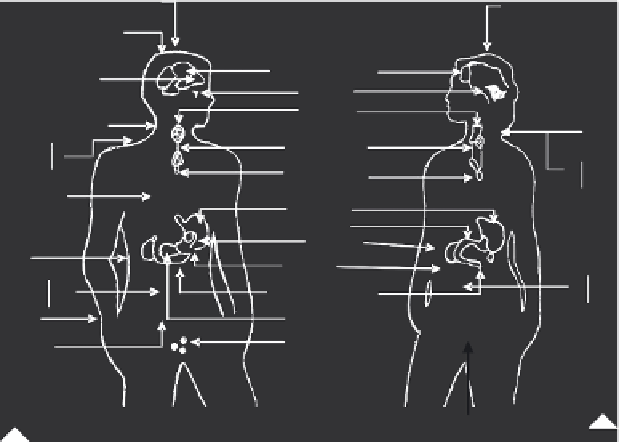Environmental Engineering Reference
In-Depth Information
are likely to be exposed to higher levels of even more dangerous classes of pesticides.
It seems due to the lack of specific legislation, poor living conditions, shortage of food-
stuffs, limited subsidies for farmers, and insufficient pesticide market regulation.
A number of pesticides are persistent, lipid soluble, nonbiodegradable, accumulative,
and also endocrine disruptors. Exposure to pesticides displaying a hormone-like molecu-
lar structure has been attracting scientific interest as a consequence of the observed asso-
ciation with several biological hazards in humans and animals. In some cases, pesticides
may bind to sex hormone receptors, activate them, and thus lead to responses similar to
endogenous estrogens and androgens. They may also bind to hormone receptors without
activating them. Thus, they block the binding of endogenous hormones, which therefore
become inactive. On the other hand, a number of indirect (anti)estrogenic and (anti)andro-
genic reactions are possible, for example, changes in the concentration of hormones at
the receptors in the target organs, interference with the biosynthesis of hormones in the
endocrine organs, or effects on the biotransformation in the liver. As a consequence, the
binding of hormones to proteins in the blood plasma as well as the endocrine activity of
pituitary and hypothalamus may be influenced. This may be due to the complex nature of
the combined effects of contaminants present in the environment.
Therefore, numerous papers, several reviews, and many topics have been published on
the subject.
Endocrine systems and hormones are briefly discussed before discussing pesticides
and their endocrine-disrupting effects. In the last part, endocrine-disrupting effects of the
well-known pesticide DDT and its metabolites are detailed.
Figure 20.1 shows the position of the endocrine glands and health hazards associated
with the extensive use of pesticides.
Giddiness-headache 26
6 Giddiness-headache
Headache-vomiting-
eye irritation 7
Eye burning
sensation 11
Hypothalamus
Pituitary
yroid
Cough 4
2 Cough
Recurrent cold
fever
Run down health
Recurrent cold
fever
Run down health
Chest pain 4
Parathyroids
4
1
ymus
Stomach
pancreas
Adrenals
Back ache 1
Loss of appetite,
diarrhea
Kidneys
Loss of appetite,
diarrhea
1
6
Alimentary canal
Pancreas
Testes
Skin eruption 1
Abdomen pain 3
Easy fatiguability 1
Depression 1
Ovaries
Others, similar, socio-
economic group
60
Pesticides applicators
120
Persons examined
FIGURE 20.1
Position of the endocrine glands and health hazards associated with extensive use of pesticides. (
Note:
Figures
indicate number of incidents.)


Search WWH ::

Custom Search